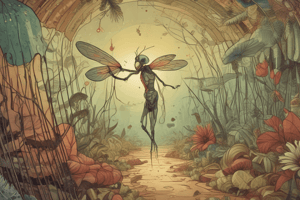Podcast
Questions and Answers
What is the primary route of transmission for cryptosporidiosis?
What is the primary route of transmission for cryptosporidiosis?
- Through vectors like mosquitoes
- Ingestion of oocysts in contaminated water (correct)
- Through airborne transmission
- Direct contact with an infected person
What is the usual time frame for symptoms of cryptosporidiosis to appear after infection?
What is the usual time frame for symptoms of cryptosporidiosis to appear after infection?
- 2-6 weeks
- 5-28 days (correct)
- 1-2 months
- 1-3 days
What is the primary mechanism of pathogenesis for cryptosporidiosis?
What is the primary mechanism of pathogenesis for cryptosporidiosis?
- Infection of the bloodstream
- Inflammation of the liver
- Damage to epithelial cells lining the intestine (correct)
- Inflammation of the intestinal wall
What is the typical length of adult hookworms?
What is the typical length of adult hookworms?
How do hookworms typically penetrate the body?
How do hookworms typically penetrate the body?
What is the primary symptom of heavy, chronic hookworm infections?
What is the primary symptom of heavy, chronic hookworm infections?
How are hookworm infections typically diagnosed?
How are hookworm infections typically diagnosed?
What is the primary method of prevention for hookworm infections?
What is the primary method of prevention for hookworm infections?
What is the primary mode of transmission of the Plasmodium parasite?
What is the primary mode of transmission of the Plasmodium parasite?
Which of the following groups is most at risk of malaria infection?
Which of the following groups is most at risk of malaria infection?
What is the primary symptom of acute malaria?
What is the primary symptom of acute malaria?
What is the purpose of RDT (Rapid Diagnostic Test) in malaria diagnosis?
What is the purpose of RDT (Rapid Diagnostic Test) in malaria diagnosis?
What is the target of the two available malaria vaccines?
What is the target of the two available malaria vaccines?
What is the primary challenge in the treatment of malaria?
What is the primary challenge in the treatment of malaria?
Study Notes
Malaria
- Caused by the parasite Plasmodium spp., a single-celled protozoan parasite
- Six different species of Plasmodium can infect humans
- Parasites also infect other animals, including primates, rodents, birds, lizards, and amphibians
- People at risk include immunologically naive individuals, predominantly children under 5, and non-immune travelers
- Life cycle involves two hosts: humans and mosquitoes
- Only female mosquitoes transmit the parasite
- Symptoms include acute malaria, fever, chills, anaemia, headache, diarrhoea, and vomiting
- Diagnosis is made through patient history, rapid diagnostic test (RDT), and PCR
- Effective antimalarials are available, but treatment outcomes can be problematic due to resistance, data in pregnancy, and counterfeit drugs
Prevention and Control
- Insect repellent, bed nets, protective clothing, chemoprophylaxis, and mosquito control can prevent malaria
- Two vaccines are available, targeting the sporozoite stage: RTS, S and R21/Matrix M
Cryptosporidium
- Causes cryptosporidiosis (crypto)
- Symptoms include diarrhoea, abdominal pain, nausea, fever, and fatigue
- Transmission occurs through the faecal-oral route, involving ingestion of oocysts in contaminated water
- Life cycle has multiple stages, and the disease is generally self-limiting but can be serious in immunocompromised individuals
- Diagnosis is made through stool sample analysis
- Treatment involves drinking fluids to prevent dehydration, and anti-parasite drugs are available
Prevention and Control
- Good hygiene practices, avoiding contaminated water sources, and boiling or filtering contaminated water can prevent cryptosporidiosis
- No vaccines are currently available
Helminths (Parasitic Worms)
- Term used for all groups of parasitic worms
- Multicellular organisms, including roundworms (nematodes) and flatworms (platyhelminths)
- Roundworms have cylindrical bodies and lack specialized attachment organs
- Flatworms have flat bodies, muscular suckers and/or hooks for attachment, and complex body organization
Helminths Infections
- Infections are common in warmer regions
- Different kinds of parasitic worms infect humans in different ways
- Larval stage: 100-200um, adult worms: cm to m long
Hookworms
- Multiple species of roundworms (nematodes)
- Transmission: eggs hatch into larvae in the soil, penetrate the skin, and are carried to the lung and then to the small intestine
- Symptoms include rash, itch at site of skin infection, mild diarrhoea, anaemia, abdominal pain, and loss of appetite and weight loss
- Diagnosis is made through faecal analysis
- Effective drugs are available, such as albendazole
- Prevention involves avoiding contact with contaminated soil and improving hygiene and sanitation
Prevention and Control
- No vaccines are currently available for hookworms
Studying That Suits You
Use AI to generate personalized quizzes and flashcards to suit your learning preferences.
Description
This quiz covers the biology and transmission of malaria, including the Plasmodium parasite, its hosts, and the life cycle of the disease.




